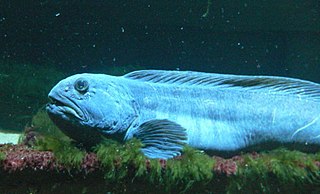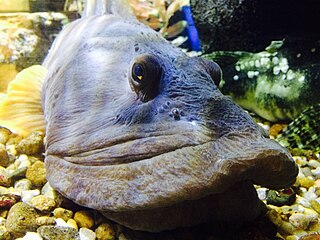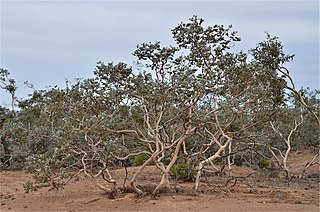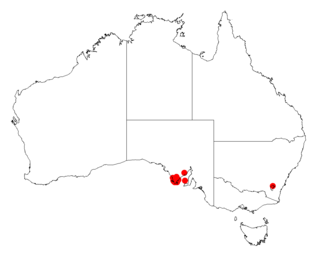
The viviparous eelpout, also known as the, viviparous blenny and European eelpout is species of marine ray-finned fish belonging to the family Zoarcidae, the eelpouts. It is notable for being ovoviviparous and gives birth to live larvae. It is a common soup ingredient in Mediterranean countries. The bones are of greenish colour, due to a harmless pigment. Their skin is slimy and the colour is variable.

Poecilia is a genus of fishes in the family Poeciliidae of the order Cyprinodontiformes. These livebearers are native to fresh, brackish and salt water in the Americas, and some species in the genus are euryhaline. A few have adapted to living in waters that contain high levels of toxic hydrogen sulfide and a population of P. mexicana lives in caves.
Zoarces is a genus of marine ray-finned fishes belonging to the family Zoarcidae, the eelpouts. It is the only genus in the subfamily Zoarcinae. These eelpouts are found in the northern Atlantic and northern Pacific Oceans.

Acantholimon is a genus of small flowering plants within the plumbago or leadwort family, Plumbaginaceae. They are distributed from southeastern Europe to central Asia and also in South America, but also cultivated elsewhere in rock gardens.

Zoarcoidei is a suborder of marine ray-finned fishes belonging to the order Scorpaeniformes. The suborder includes the wolffishes, gunnels and eelpouts. The suborder includes about 400 species. These fishes predominantly found in the boreal seas of the northern hemisphere but they have colonised the southern hemisphere.

The ocean pout is an eelpout in the family Zoarcidae. It is found in the Northwest Atlantic Ocean, off the coast of New England and eastern Canada. The fish has antifreeze proteins in its blood, giving it the ability to survive in near-freezing waters.
Gába is a bilingual Sámi magazine that is published six times a year by the Sámi women's forum Sami Nisson Forum and that has funds earmarked for it in the annual budget of the Sami Parliament of Norway. The magazine was published for the first time on International Women's Day in 1996. Although the main languages are Norwegian and Northern Sámi, articles are occasionally written in Southern Sámi, Lule Sámi and Swedish. The articles mainly deal with the everyday life of the Sámi from a woman's perspective.
Apiodiscus is a genus of fungi in the Rhytismatales order. The relationship of this taxon to other taxa within the order is unknown, and it has not yet been placed with certainty into any family. This is a monotypic genus, containing the single species Apiodiscus gillii.

Eucalyptus gillii, known as the curly mallee, Arkaroola mallee, or silver mallee, is a species of mallee or small tree that is endemic to inland Australia. It has smooth bark, sometimes with rough bark near the base, often only juvenile, usually glaucous leaves in the crown, flower buds in groups of between seven and eleven, pale yellow flowers and barrel-shaped or shortened spherical fruit.
Zoarces elongatus, also known as the eastern viviparous blenny is an eelpout in the family Zoarcidae, described by Rudolf Kner in 1868. The species is endemic to the Northwest Pacific, in such areas as the Sea of Japan and the Sea of Okhotsk and China.
Zoarces fedorovi is an eelpout in the family Zoarcidae, found only in the northern part of the Sea of Okhotsk.
Bassogigas gillii is a species of cusk-eel found in the Indian, Pacific Ocean, and Atlantic Oceans at depths of from 637 to 2,239 metres.
Arceuthobium gillii, common name "Chihuahua pine dwarf mistletoe," is a parasitic plant found in Arizona, New Mexico, Chihuahua, Sonora and Sinaloa. It is found mostly on the Chihuahua pine, Pinus leiophylla var. chihuahuana.
Allium gillii is a plant species found in Pakistan and Afghanistan. It is a bulb-forming perennial up to 35 cm tall, with an umbel of long-pediceled pale purple flowers.

Acacia gillii, commonly known as Gill's wattle, is a shrub belonging to the genus Acacia and the subgenus Phyllodineae that is native to parts of southern Australia.
Sámi Áigi was a Northern Sámi-language weekly newspaper established in 1978, providing an alternative to the Norwegian-language Sámi publication Ságat. Sámi Áigi played a prominent role in building and empowering Sámi identity during the Alta controversy and throughout the 1980s.
Alexander Gilli was an Austrian botanist and pteridologist. He was a pioneer in research on plant communities.
Acantholimon gillii is a species of plant described by Karl Heinz Rechinger and Mogens Engell Köie. Acantholimon gillii is part of the genus Acantholimon and the family Plumbaginaceae. No subspecies are listed in the Catalog of Life.
Lake Shore Gill was a botanist and forest pathologist for the U.S. Department of Agriculture. He was a definitive authority on the genus Arceuthobium.
Lycozoarces is a monospecific genus of marine ray-finned fish belonging to the family Zoarcidae, the eelpouts, its only species being Lycozoarces regani. It is the only genus in the monogeneric subfamily Lycozoarinae. This taxon occurs in the northwestern Pacific Ocean in the Sea of Okhotsk and the Tatar Strait in the northern Sea of Japan






